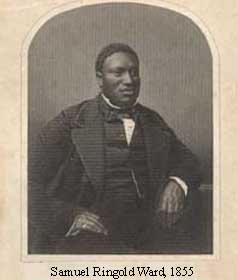William "Jerry" Henry's
Escape
The great Daniel Webster came to Syracuse in
May of 1851 and threatened enforcement of the Fugitive Slave Law
during the next anti-slavery convention in Syracuse. He had his
chance five months later during an anti-slavery convention.
Around noon on October 1, federal marshals
from Rochester, Auburn, Syracuse, and Canandaigua, accompanied
by the local police, arrested William "Jerry" Henry.
Jerry was working as a barrel maker, and was arrested at his Syracuse,
NY workplace. He was originally told the charge was theft until
after he was in manacles. On being informed that he was being
arrested under the Fugitive Slave Law, he put up substantial resistance,
but was subdued.
|
Word of the arrest quickly reached the Convention,
then in session at a nearby church. There are reports that the
wife of Commissioner Sabine, who would hear the case, had already
leaked plans of the arrest.
"Fellow citizens! We are here in the
most extraordinary circumstances," ex-slave
Samuel Ward, the man Frederick Douglas called "the
ablest man the country has ever produced," told a gathering
at an October 1, 1851 gathering in Clinton Square of Syracuse.
"We are witnessing such a sight as, I pray, we may never
look upon again. A man in chains, in Syracuse! ...
"We have arrested him, confined him and
chained him on purpose to inflict upon him the curses of slavery.
They say he is a slave. What a term to apply to an American!
How does this sound beneath the pole of liberty and the flag
of freedom?
Ward told the residents they were responsible,
in part, for the existence of the Fugitive Slave Law because
they elected the men who made it law. He asked the crowd: "Do
you promise, so help you God, so to vote, as that your sanction
never more shall be given to laws which empower persons to hunt,
chain and cage men in our midst?"
|

|
By pre-arranged signal, church bells began
ringing, and a crowd of Negroes and Whites gathered at Sabine's
office, where Jerry had been taken for arraignment. An immediate
effort to free the prisoner was unsuccessful, and though he escaped
to the street in irons, he was rapidly recaptured. The arraignment
was put off until evening and relocated to a larger room. A large
crowd gathered in the street, this time equipped for a more serious
rescue attempt.
With a battering ram the door was broken in
and despite pistol shots out the window by one of the deputy marshals,
it became clear that the crowd was too large and determined to
be resisted. The crowd broke into the jail and forced the marshals
to free William "Jerry" Henry. One deputy marshal broke
his arm jumping from a window to escape the crowd. The injured
prisoner was hidden in the city for several days in the home of
a local butcher known for his anti-abolitionist sentiments.
The Rev. (and later Bishop of the AMEZ church)
Jermain Wesley Loguen
and Sam May of Syracuse helped organize the escape of Jerry's
escape who was taken in a wagon to the home of William Lyman Salmon
in Oswego, from which he crossed Lake Ontario into Canada. Later
Loguen was indicted and escaped to Canada until tensions in Syracuse
eased. It is interesting to note that William Seward (former New Yrok governor, later US
Senator and of the Seward's folly fame) signed the bail bond for
those indicted in the Rescuers of Jerry Henry (he was not present
for the rescue).
reference: Pettit;
Loguen;
Jerry rescue;
Back to African
American History of Western New York 1830 to 1865.
